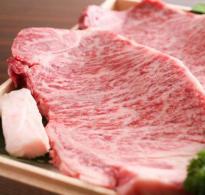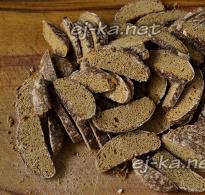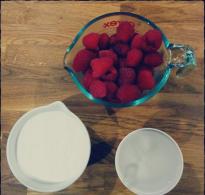Homemade Dutch cheese made from cottage cheese. Homemade Dutch hard cheese
1. First you need to pour the milk into a large saucepan and put it on the fire. To make cheese, you need a thermometer to monitor the temperature of the milk. When it reaches 30-32 degrees, remove the milk from the heat and introduce the starter. Mix gently and leave for 30 minutes. Meanwhile, dissolve the enzyme in a small amount of water and pour it into the pan. Maintaining the temperature of the milk, leave it for 35-40 minutes. You will get a very dense clot, which must be carefully cut into medium pieces with a knife.

2. The next step is to gently mix the mass for 15 minutes. Classic recipe Making Dutch hard cheese at home requires patience and time.

3. Now you need to carefully drain off about a third of the separated whey.

4. You need to add water to the milk mass (about 40 degrees) and maintain the temperature of the milk at 37 degrees.

5. Prepare cheese molds. If there are no special forms at hand, you can use small containers with pre-drilled holes in them. The molds need to be placed in a large container in which the whey will be collected and covered with gauze.

6. Carefully transfer cheese mass into the molds, gradually adding from the pan. This process can take a long time, since quite a lot of whey will be released at once.

7. After the main part of the whey has drained, you need to put a press of about 3-4 kilograms on the cheese for 30 minutes.

8. Then the cheese needs to be turned over and the press increased to 16 kilograms for another 30 minutes. Next - 25 kilograms, after turning over for another half hour. Turn the cheese over again to ensure it is evenly compressed and leave under the 25 kilogram weight for 6-8 hours. There is also another option for how to cook Dutch hard cheese at home and make it more dense - you need to leave it under a weight of about 50 kilograms overnight.

9. Cheese must be placed in saline solution and leave for about 10-12 hours. Then dry for 2-3 days in the refrigerator. For the shell, you can use wax or special cheese bags. The cheese should be left to ripen at a temperature of about 10 degrees and high humidity for at least 2 months. If you are patient, you will have excellent Dutch hard cheese at home in 6 months.
This is a proven technology for making hard cheese, very similar to store-bought cheese.
Many people think that buying cheese is much easier than making it yourself.
But when buying Dutch cheese in a store, we don’t think about what it’s made of, how many preservatives it contains, or what it will taste like.
In fact, homemade Dutch hard cheese, prepared at home, will be the most natural product.
And the cooking process homemade cheese will take you much less time if you use step by step recipe with photo.
Ingredients:
- milk (cow's, homemade) - 12 l
- rennet milk-clotting agent - 0.4 g
- salt - 3 tbsp. l.
- sour cream - 200 g
Homemade Dutch cheese recipe
1. There is no need to boil milk, so you must be sure of its purity and freshness. It needs to be heated to a temperature of 34-35 C. Add sour cream, and then stir well with a whisk for 1 minute.

2. Dilute Meito enzyme in half a glass of cool boiled water.
1 bag is designed for 100 liters of milk, so for 12 liters use approximately 1/5 of the bag. Less - it may not curl, more - no big deal.
3. Pour in the dissolved enzyme and stir again for 1 minute.
After 1-2 hours, the milk will curdle - a clot will form in the form of a dense jelly.
4. Using a skewer, cut it into 3 cm squares vertically. Then we try to cut it horizontally into layers, also with a skewer or slotted spoon.
5. Leave for 15-20 minutes until the whey begins to separate.
6. Then place the pan in hot water and start stirring the cheese. The temperature should rise to 40-42 C.
You need to stir for a long time, 30-60 minutes. It is possible with breaks. The cheese grain will dry out and shrink, becoming denser.
This is what it looks like after 30 minutes.

This is in an hour. The cheese settles to the bottom of the pan. If you try it, it creaks your teeth a little, which means you’re ready.

7. Drain the whey (you can use a colander).

8. At this stage you can add salt to the cheese. When pressing, a lot of salt will be lost, so it will not be very salty.
The cheese does not need to be salted before placing in the mold. Then it needs to be kept for 24 hours.

9. Place the cheese grain in the mold. If you haven't purchased one yet, try using a plastic bucket for this, making holes to drain the whey.

You can also hang the cheese this way to ensure good whey drainage.
In a suspended state, the ladle presses on the cheese and the whey is well separated and flows down.
11. Ready homemade Dutch cheese You need to wipe it dry, place it on a clean dry cloth and put it in the refrigerator to ripen for at least 3 weeks.

Every 2-3 days, turn the cheese over and replace the cloth with a dry one.
Homemade cheese will turn yellow and develop a crust, acquire sharpness, holes and the correct structure.
Cheese production in Holland began in the 1st century BC. The Dutch adopted cooking recipes from the Romans, adding their own flavor and improving the technology. In the Middle Ages, cheese was a hard currency. Nowadays, Dutch cheeses have become one of the most popular in the world. There are:
We are happy to tell you how to make Dutch cheese at home.
Dutch cheese recipe
Ingredients:
- milk: 3 l;
- cottage cheese: 2 kg;
- butter: 100 g;
- egg: 1 pc.;
- soda: 0.5 tsp;
- salt: to taste.
Heat the milk, add pre-pounded cottage cheese before boiling. Mix. Cook for low heat while stirring constantly. Remove from heat when the whey appears. Then pour the rubbery mass into a colander. Melt the butter in another pan, add the cheese, cook over low heat, stirring continuously. Add the egg beaten with salt and soda. Remove from heat when the mixture thickens and becomes yellow. When the cheese has cooled a little, fold it back, stir and shape into a sausage. Wrap it in foil or hard cellophane and put it in the refrigerator. The cheese is ready.
Recipe for making Gouda cheese from goat's milk
Ingredients:
- goat milk: 16 l;
- mesophilic lactic acid bacteria: 0.5 tsp;
- calcium chloride: 3/4 tsp;
- liquid rennet starter: 0.5 tsp;
- salt;
- wax for cheese.
Place the pan with milk in a well-heated water bath, heat to 29°C, turn off the stove. Lactic acid bacteria Place on the surface of the milk. After 5 minutes, stir to the very bottom from top to bottom using a slotted spoon, without shaking. Calcium chloride is diluted in 50 ml cold water, add to milk. Mix well. We do the same with rennet. Cover with a towel and leave for 30 minutes over low heat, at a temperature of 29°C. Using a knife with a long blade at an angle of 30°, we will try to lift the cheese mass up. If it crumbles, then you can cut it, if not, then leave it for another 5 - 10 minutes and try again. Cut the mass in the pan into squares 1.2 cm wide. Cut through the entire mass with a slotted spoon every 1.2 cm. Leave for 6 minutes. The whey will begin to separate. Stir, leave for 5 minutes, curd mass should settle, if this does not happen, then do the same after another 5 minutes.
Pour in 1.5 liters of whey. Pour water in the same volume at a temperature of 60°C. Cook to a temperature of 33°C. Stir constantly. Leave for 10 minutes. During this time, the curd should settle and thicken.
Drain 1/3 of the whey and add water in the same volume at a temperature of 43°C. Stir for 20 minutes. During this time, the width of the cubes will become 0.5 cm. Leave for 9 - 11 minutes. Drain off the whey.
Place the cottage cheese in a large cheese pan lined with gauze. We collect the fabric in a bag and bandage it. Cover the container with a lid of a smaller diameter and place it under pressure for 30 minutes or in a press. Transfer the cheese to clean gauze and press for 7 – 11 hours.
We soak the cheese in brine for 6 hours, which is prepared as follows: mix water with salt in a ratio of 5:1. Heat until the salt is completely dissolved. Cool to 13°C. Afterwards, put the cheese on a baking rack and leave it in the kitchen for 2 - 3 days. It needs to be turned once a day.
We transfer the cheese into a 30-liter container, put a plastic cutting board on top, and a mat on top. Close the lid and leave to ripen for 1 week at a temperature of 10 - 12°C and a humidity of 85%. Afterwards, cover with 2 - 3 layers of cheese wax. Transfer to a container for further ripening for 5 weeks to several months. It needs to be turned over every week.
Making Gouda cheese at home takes a lot of time. for a long time. But it's worth it. The product turns out to be very tasty and aromatic, and most importantly natural. To facilitate this labor-intensive process, special equipment will help, which can be purchased in the online store website.
Published/updated: 2011-11-30 08:30:30. Views: 87915 |Such popular product like you usually buy cheese in a store. But what if you try to cook it at home and pleasantly surprise your family? And the recipe is not complicated.
What do you need to make your own Dutch cheese?
To make cheese at home, we need 3 liters of milk. 2 kg of cottage cheese, 100 g of butter, 1 egg, soda, salt.How to make Dutch cheese at home - a simple recipe step by step
At this stage it is important not to overcook as this will make the cheese too hard. We look when the cheese becomes rubbery and whey forms. Place everything in a colander and press lightly to drain the whey.
Stir all the time and make sure that it doesn’t stick, otherwise the cheese will taste like burnt milk. The liquid mass takes on the consistency of whipped cream, and when it thickens and turns yellow, turn off the heat.
So we made Dutch cheese at home. And such by-product as whey can be used in dough for pies or dumplings.
It’s also delicious to add melted cheese to the dish you’re serving, be it meat languette, cabbage dishes, or soup. This cheese will not spoil the taste and will give you fullness.
You must try to take care of your health, and here it will be useful to learn about what scams can await you in the supermarket. Tricks with fish. Watch the video from the Habitat series.
NOW ALSO READING
How labor and contractions begin  Labor can begin suddenly from 36 weeks at any time. Most often, birth occurs at 38-39 weeks. There are certain precursors to childbirth. ...
Labor can begin suddenly from 36 weeks at any time. Most often, birth occurs at 38-39 weeks. There are certain precursors to childbirth. ...
How does orgasm occur in women?  The function of orgasm in women The formation of the function of orgasm in women begins from the moment of birth and generally ends by the age of three...
The function of orgasm in women The formation of the function of orgasm in women begins from the moment of birth and generally ends by the age of three...
How to make cream for cakes and pastries - recipes for every taste  Cream is a magical confectionery component that transforms regular sponge cake or crust into a cake or pastry. Well, what else can give baked goods a special charm...
Cream is a magical confectionery component that transforms regular sponge cake or crust into a cake or pastry. Well, what else can give baked goods a special charm...
Hygienic lipstick and its importance.  Chapped lips are a problem that worries not only women, but also men. Negative influence on our lips more often occur during wind, frost, ...
Chapped lips are a problem that worries not only women, but also men. Negative influence on our lips more often occur during wind, frost, ...
8 tips for choosing a carpet 
In addition to complementing the decor, a rug has other benefits. The room becomes comfortable and cozy. It also retains heat in...
How does orgasm occur in men? 
What happens to us during orgasm? This question interests many. Let's try to figure this out. ...










